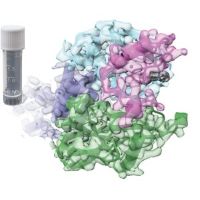Specification
| Organism | Influenza A virus (strain A/USA:Iowa/1943 H1N1) |
| Expression Host | E.coli |
| Tag Info | N-terminal 10xHis-tagged and C-terminal Myc-tagged |
| Purity | Greater than 85% by SDS-PAGE |
| Uniprot ID | A4GCL0 |
| Gene Names | M |
| Alternative Names | M; Matrix protein 1; M1 |
| Expression Region | Full Length(1-252aa ) |
| Molecular Weight | 32.8 kDa |
| Protein Sequence | MSLLTEVETYVLSIVPSGPLKAEIAQRLEDVFAGKNTDLEALMEWLKTRPILSPLTKGILGFVFTLTVPSERGLQRRRFVQNALNGNGDPNNMDRAVKLYRKLKREITFHGAKEIALSYSAGALASCMGLIYNRMGAVTTEVAFGLVCATCEQIADSQHRSHRQMVTTTNPLIRHENRMVLASTTAKAMEQMAGSSEQAAEAMEVASQARQMVQAMRAIGTHPSSSAGLKNDLLENLQAYQKRMGVQMQRFK |
| Form | Liquid or Lyophilization |
| Buffer | The default storage buffer is Tris/PBS-based buffer, 5%-50% glycerol if the delivery form is liquid. The lyophilization buffer is Tris/PBS-based buffer, 6% Trehalose, pH 8.0 if the delivery form is lyophilized powder. Please contact us if you have any special requirment. |
| Reconstitution | Please reconstitute protein in deionized sterile water and we recommend that briefly centrifuge thevial prior to opening the vial .We recommend aliquot for long-term storage at -20℃/-80℃. |
Background
| Relevance | Plays critical roles in virus replication, from virus entry and uncoating to assembly and budding of the virus particle. M1 binding to ribonucleocapsids (RNPs) in nucleus seems to inhibit viral transcription. Interaction of viral NEP with M1-RNP is thought to promote nuclear export of the complex, which is targeted to the virion assembly site at the apical plasma membrane in polarized epithelial cells. Interactions with NA and HA may bring M1, a non-raft-associated protein, into lipid rafts. Forms a continuous shell on the inner side of the lipid bilayer in virion, where it binds the RNP. During virus entry into cell, the M2 ion channel acidifies the internal virion core, inducing M1 dissociation from the RNP. M1-free RNPs are transported to the nucleus, where viral transcription and replication can take place Determines the virion's shape: spherical or filamentous. Clinical isolates of influenza are characterized by the presence of significant proportion of filamentous virions, whereas after multiple passage on eggs or cell culture, virions have only spherical morphology. Filamentous virions are thought to be important to infect neighboring cells, and spherical virions more suited to spread through aerosol between hosts organisms |
| Involvement in Disease | |
| Subcellular Location | Virion membrane, Peripheral membrane protein, Cytoplasmic side, Host nucleus |
| Protein Families | Influenza viruses Matrix protein M1 family |
| Tissue Specificity | M |
QC Data
| Note | Please contact us for QC Data |
| Product Image (Reference Only) |  |

